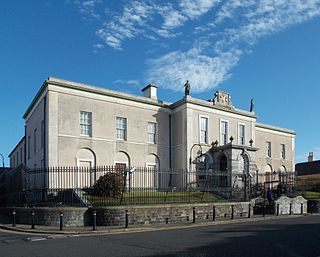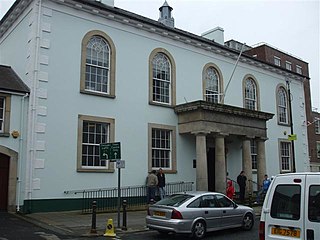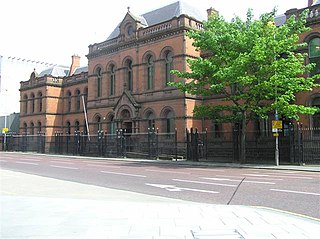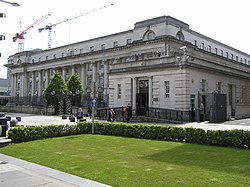The Courts of England and Wales, supported administratively by His Majesty's Courts and Tribunals Service, are the civil and criminal courts responsible for the administration of justice in England and Wales.

Parliament Buildings, often referred to as Stormont, because of its location in the Stormont Estate area of Belfast, is the seat of the Northern Ireland Assembly, the devolved legislature for Northern Ireland. The purpose-built building, designed by Arnold Thornely, and constructed by Stewart & Partners, was opened by Edward, Prince of Wales, in 1932.
The Great Seal of Northern Ireland is the seal used for Northern Ireland. The great seal is in the possession of the Secretary of State for Northern Ireland. The Great Seal was created by the Irish Free State Act 1922 on the creation of Northern Ireland for possession by the Governor of Northern Ireland to "be used for all matters in Northern Ireland for which the Great Seal of Ireland was theretofore used".

Belfast Castle is a mansion located in Cave Hill Country Park in Belfast, Northern Ireland, in a prominent position 400 feet (120 m) above sea level. Its location provides unobstructed views over the City of Belfast and Belfast Lough. There have been several structures called "Belfast Castle" over the centuries, located on different sites. The current "castle" is a Victorian structure, built between 1867 and 1870 on the slopes of Cave Hill, and is Grade A listed. The main entrance into the Belfast Castle Demesne is now where Innisfayle Park meets Downview Park West, just off the Antrim Road. The original main entrance into the current demesne was formerly on the Antrim Road itself, where Strathmore Park now meets the Antrim Road.
The courts of Northern Ireland are the civil and criminal courts responsible for the administration of justice in Northern Ireland: they are constituted and governed by the law of Northern Ireland.
The Northern Ireland Courts and Tribunals Service runs the courts of Northern Ireland. It is a court administration agency of the Department of Justice for Northern Ireland. The Court of Judicature for Northern Ireland, county courts, magistrates’ courts, coroners’ courts and certain tribunals are all administered by the Courts and Tribunals Service. The NICTS employs approximately 830 staff members.

The Cathedral Quarter in Belfast, Northern Ireland, is a developing area of the city, roughly situated between Royal Avenue near where the Belfast Central Library building is, and the Dunbar Link in the city centre. From one of its corners, the junction of Royal Avenue, Donegall Street and York Street, the Cathedral Quarter lies south and east. Part of the area, centred on Talbot Street behind the cathedral, was formerly called the Half Bap. The "Little Italy" area was on the opposite side of Great Patrick Street centred on Little Patrick Street and Nelson Street.

The Crumlin Road Courthouse is a former judicial facility on Crumlin Road in Belfast, Northern Ireland. It is a Grade B+ listed building.

Divis Tower is a 19-floor, 200-foot (61 m) tall tower in Belfast, Northern Ireland. It is located in Divis Street, which is the lower section of the Falls Road. It is currently the fifteenth-tallest building in Belfast.

The buildings and structures of Belfast, Northern Ireland comprise many styles of architecture ranging from Edwardian through to state-of-the-art modern buildings like the Waterfront Hall. The city's beautiful Edwardian buildings are notable for their display of a large number of sculptures. Many of Belfast's Victorian landmarks, including the main Lanyon Building at Queens University in 1849, were designed by Sir Charles Lanyon.
The courts of assizes or assizes were the higher criminal court in Ireland outside Dublin prior to 1924. They have now been abolished in both jurisdictions.

Lisburn Courthouse is a judicial facility in Railway Street in Lisburn, County Antrim, Northern Ireland. It is home to the magistrate's and county courts.

Armagh Courthouse is a judicial facility in Armagh, County Armagh, Northern Ireland. The courthouse, which accommodates hearings for the local magistrates' courts and county courts, is a Grade A listed building.

Downpatrick Courthouse is a judicial facility on English Street, Downpatrick, County Down, Northern Ireland. The courthouse, which served as the headquarters of Down County Council from 1878 to 1973, is a Grade B+ listed building.

Enniskillen Courthouse is a judicial facility in East Bridge Street, Enniskillen, County Fermanagh, Northern Ireland. It is a Grade B listed building.

The Bishop Street Courthouse is a judicial facility in Bishop Street, Derry, County Londonderry, Northern Ireland. It is a Grade A listed building.

Omagh Courthouse is a judicial facility in High Street, Omagh, County Tyrone, Northern Ireland. It is a Grade B+ listed building.

The Old Courthouse is a former judicial facility on Castlerock Road in Coleraine, County Londonderry, Northern Ireland. It is a Grade B1 listed building.

The Old Town Hall is a municipal structure in Victoria Street, Belfast, Northern Ireland. The structure, which has most recently been used as courthouse, is a Grade B1 listed building.
















